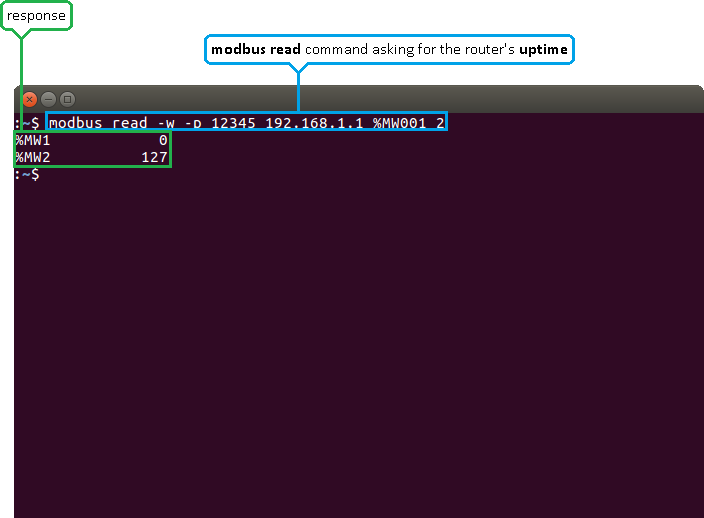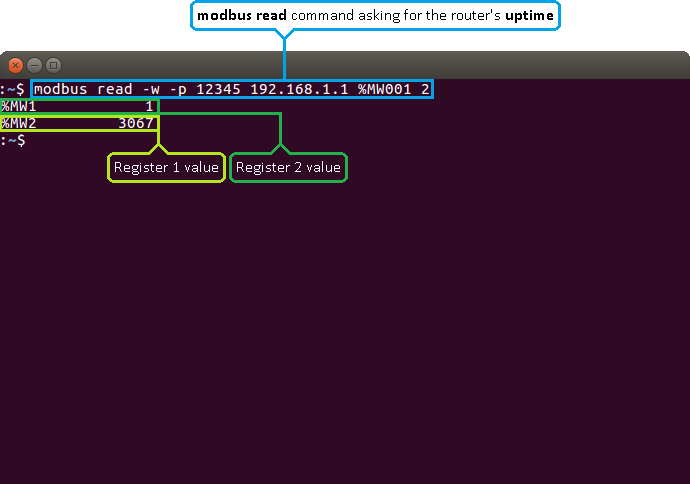Monitoring via Modbus: Difference between revisions
No edit summary |
|||
| Line 158: | Line 158: | ||
==Interpreting the response== | ==Interpreting the response== | ||
The values are returned in decimal and, if you add '''-D''' to the command, hexadecimal forms. Sometimes the answer is self-explanatory as in the example above. But, since a register only hold 2 bytes (16 bits) of information, the value stored in a register can't be higher than '''65535'''. So what happens if the router's uptime is higher than that? Lets examine another example where the router's uptime is higher than 65535: | The values are returned in decimal and, if you add '''-D''' to the command, hexadecimal forms. Sometimes the answer is self-explanatory as in the example above. But, since a register only hold 2 bytes (16 bits) of information, the value stored in a register can't be higher than '''65535 (2<sup>16</sup>)'''. So what happens if the router's uptime is higher than that? Lets examine another example where the router's uptime is higher than 65535: | ||
[[File:Configuration examples modbus higher uptime example.png]] | [[File:Configuration examples modbus higher uptime example.png]] | ||
When the value climbs over 65535 | |||
Revision as of 15:36, 6 December 2017
Router monitoring via Modbus TCP Linux guide applies to RUT950 and RUT955 routers.

Summary
Modbus is a serial communications protocol originally published by Modicon (now Schneider Electric) in 1979 for use with its programmable logic controllers (PLCs). Modbus has become a de facto standard communication protocol and is now a commonly available means of connecting industrial electronic devices. The main reasons for the use of Modbus in the industrial environment are:
- developed with industrial applications in mind,
- openly published and royalty-free,
- easy to deploy and maintain,
- moves raw bits or words without placing many restrictions on vendors.
Modbus enables communication among many devices connected to the same network, for example, a system that measures temperature and humidity and communicates the results to a computer. Modbus is often used to connect a supervisory computer with a remote terminal unit (RTU) in supervisory control and data acquisition (SCADA) systems. Many of the data types are named from its use in driving relays: a single-bit physical output is called a coil, and a single-bit physical input is called a discrete input or a contact.
This chapter is a guide on how to use Modbus TCP to monitor RUT950 and RUT955 routers using a Linux Operating System.
Configuring the router
In order to start using Modbus TCP, we must first configure the router. Modbus TCP configuration from the router's side is very simple. All you need to do is log in to the router's WebUI, go to Services → Mobdus, Enable the Modbus TCP service, enter a Port number through which the Modbus TCP communication will take place and Allow remote access if you wish to connect to the router remotely (from WAN).
Installing the necessary software
Next you'll need software capable of communicating via Modbus TCP. The software that we'll be using for this guide is called modbus-cli. To get it you'll first have to install ruby. To do so, open the Terminal app and enter these commands.
$ sudo apt-get install ruby $ sudo gem instal modbus-cli
Getting router parameters
Modbus TCP can be used to both get and set certain router parameters. First lets do an overview of how to get parameters via Modbus TCP.
List of parameters
Router parameters are held within registers. Each register contains 2 bytes of information. For simplification the number of registers for storing numbers is 2, while the number of registers for storing text information is 16. The register numbers and corresponding system values are described below:
| Required value | Representation | Register number | Number of registers |
|---|---|---|---|
| System uptime | 32 bit unsigned integer | 1 | 2 |
| GSM signal strength (dBm) | 32 bit integer | 3 | 2 |
| System temperature in 0.1 degrees Celcius | 32 bit integer | 5 | 2 |
| System hostname | Text | 7 | 16 |
| GSM operator name | Text | 23 | 16 |
| Router serial number | Text | 39 | 16 |
| Router MAC address | Text | 55 | 16 |
| Router name | Text | 71 | 16 |
| Current SIM card | Text | 87 | 16 |
| Network registration | Text | 103 | 16 |
| Network type | Text | 119 | 16 |
| Digital input 1 | 32 bit integer | 135 | 2 |
| Digital input | 32 bit integer | 137 | 2 |
| Current WAN IP address | 32 bit unsigned integer | 139 | 2 |
| Analog input | 32 bit integer | 141 | 2 |
modbus read
To obtain parameters from the system, the modbus read command is used. The syntax for this command is:
$ modbus read [OPTIONS] HOST_NAME REGISTER_NUMBER NUMBER_OF_REGISTERS
OPTIONS can describe things like data type, port number, type of addressing, etc.
HOST_NAME is the router's hostname or IP address (WAN IP, if you are connecting remotely).
REGISTER_NUMBER specifies the register that you wish to read.
NUMBER_OF_REGISTERS specifies how many registers should be read starting from the register specified in REGISTER_NUMBER.
Note: all of this information and more can be viewed by entering this command: modbus read -h or modbus read --help.
For example, lets use this command to get the router's uptime value in seconds. If you look back at the table above, you will see that the uptime value is stored in two registers starting from the first register, therefore:
$ modbus read -w -p 12345 192.168.1.1 %MW001 2
-w specifies the data type. In this case, unsigned 16 bit integers.
-p specifies the port number.
192.168.1.1 - the router's LAN IP address.
%MW001 specifies the register number.
2 - specifies how many registers should be read.
As you can see from the example above, the router returns the values stored in two registers: the first one and the second one. The values returned are presented in decimal form.
Interpreting the response
The values are returned in decimal and, if you add -D to the command, hexadecimal forms. Sometimes the answer is self-explanatory as in the example above. But, since a register only hold 2 bytes (16 bits) of information, the value stored in a register can't be higher than 65535 (216). So what happens if the router's uptime is higher than that? Lets examine another example where the router's uptime is higher than 65535:
When the value climbs over 65535



